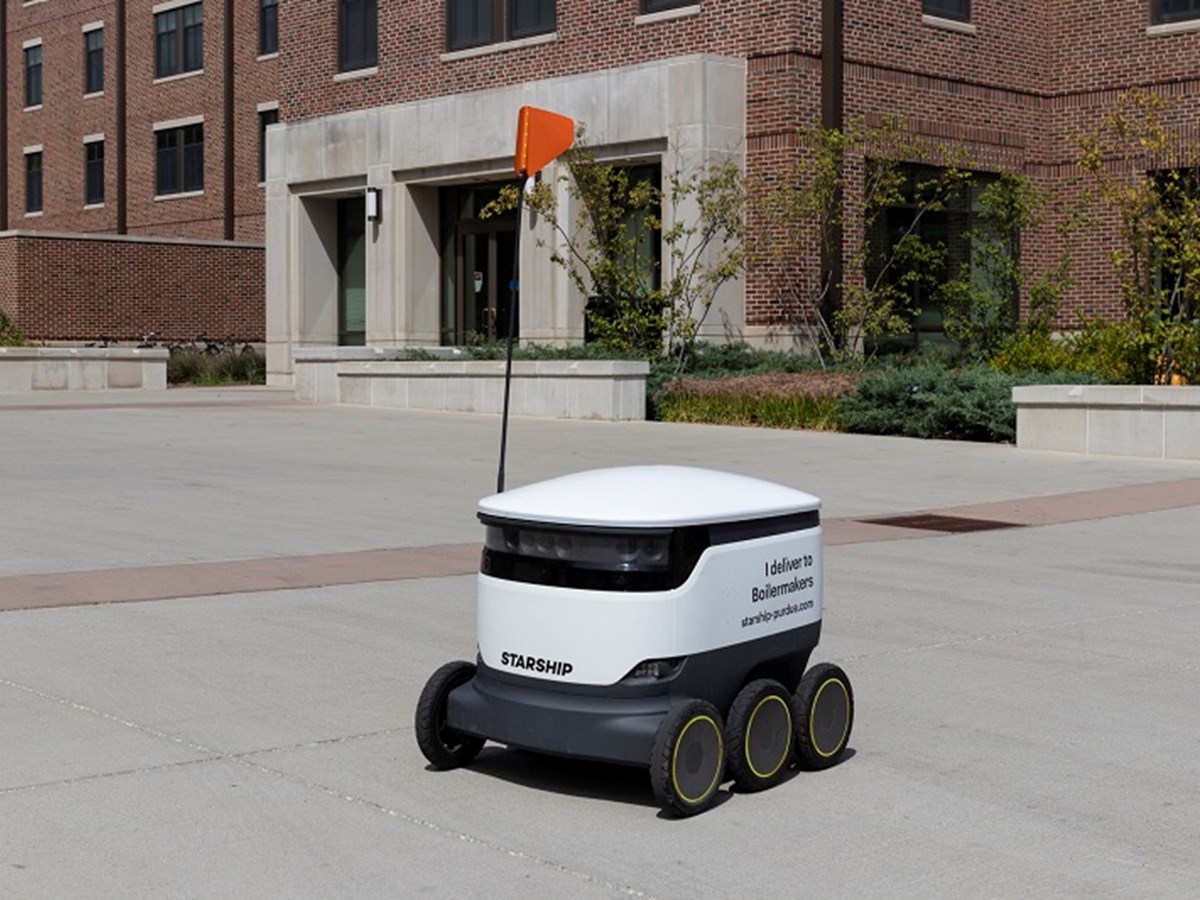Professor Matthew Cook & Dr Miguel Valdez, School of Engineering and Innovation, The Open University, Milton Keynes, UK.
Dr Aidan While, The Urban Institute, University of Sheffield, Sheffield, UK.
No longer artefacts of science fiction, artificially intelligences (AIs) and robot applications are becoming increasingly embedded in our towns and cities. Urban AI can now be found in transport systems such as in robots for grocery delivery and connected autonomous vehicles, as well as in city governance, planning and design practices in the form of so-called digital twins. Adoption rates are set to increase as technologies develop and become more accepted. Infrastructures are being reshaped to facilitate and create space for robotics. A pressing question for planning is how to respond to robots and AI. How might planning anticipate future change that is unfolding and uncertain? What are the challenges and opportunities for planning?

A grocery delivery robot
Cities have been subject to successive waves of socio-technical innovation. For example, during the last decade sensor networks and big data hubs have been installed in many cities under the auspices of ‘smart city’ developments. While quite diverse in nature, a common feature of smart city developments is the datafication of extant city infrastructures, systems and practices, e.g., transport.
Urban AI and associated mechatronics (e.g. robots) and systems constitute the very latest wave of socio-technical change to hit cities. To function, AIs have to learn from the environments in which they are situated. They have a voracious appetite for data and thus the so-called ‘big data’ collected in smart city initiatives are useful and indeed necessary feeding grounds. However, while it is tempting to think that AI is the next step in a data-based socio-technical trajectory embodied in smart city initiatives, AIs are quite different to smart city developments and raise particular challenges requiring planning and governance responses.
Firstly, smart city developments provide data to human actors in urban governance networks for decision support purposes. In contrast AI based technologies draw on a wider range of data sources to learn, make decisions and act – under human supervision or otherwise. Thus AIs are new urban actors who cannot be ignored as without human oversight they may restructure the already technicised relations which constitute the urban.
Secondly, artificial intelligences (AIs) and robotics deployed in urban transport, mobility and communication systems pose significant practical challenges for urban governance around issues of justice and sustainability and the types of places that we want to live in. For example, autonomous vehicles might lead to more efficient use of road space, but they might also reinforce the primacy of individual cars at the expense of collective transport, potentially increasing and intensifying the use of roads and pricing some social groups out of driving.
Thirdly, and related to the above, AIs know and act in profoundly different ways to humans. On one hand the ability of AIs to think and act differently may offer considerable utility in achieving the kinds of deep structural transformations which are likely to be required to meet the challenges of climate change. On the other hand, AIs ability to think differently and act autonomously and the potential prioritisation of narrow and fragmented goals of efficiency might lock us into unwanted futures that exceed human governance and management capacities. Although such concerns may be exaggerated, there is clearly a need to ensure governments, planners and citizens set the frameworks for AI and robotics in the public interest.
Proactive frameworks are needed now to help govern and manage urban AIs in line with principles of human-centred place-making. Those frameworks would balance the benefits of AI and robotics (for example in supporting independent living, in making best use of resources), with a recognition of the dangers of new forms of infrastructural and technological lock in. That will not be easy given the speed of new technological technology, the complexities of ‘black boxed’ urban AIs, and pressures of governments to open up places to the robotic applications being developed by technology firms.
We therefore argue conceptual apparatus for governance and planning purposes may not be found in focusing on the functioning of urban AIs but in the interfaces associated with them, most importantly human-machine ones. The questions are familiar battlegrounds for planners: what sorts of places do we want to live in? What sorts of principles should shape future development? And what might that look like in terms of planning frameworks? As suggested above, taking control of urban AI and ethics is not something that can be left to the future, nor should it be left to technology firms to set that agenda.
Institutional capacities will need to be built which enable urban populations to live well with urban AIs and robotics and contemplate what kinds of more sustainable urban futures they may want to attain and avoid. We need to be mindful of the urban inequalities that AI and robotics may develop and existing ones they may reinforce. As many urban AI and robotic systems originate from environments such as factories and warehouses, we may need to resist planning new developments promoted in the name of sustainable transport that facilitate the efficient functioning of urban AI and robotics but resemble industrial environments. As with each new wave of urban technological change we have to preserve the profoundly human characteristics of cities in ways that harness the benefits of new technologies.
For further insights on urban artificial intelligences and robotics please see the following journal paper, which was written by the blog authors:
Valdez, M., & Cook, M. (2023). Humans, robots and artificial intelligences reconfiguring urban life in a crisis. Frontiers in Sustainable Cities, 5, 27.
Kovacic, M., Marvin, S. & While, A. (2023) Regulating sidewalk delivery robots as a disruptive new urban technology, Urban Geography


